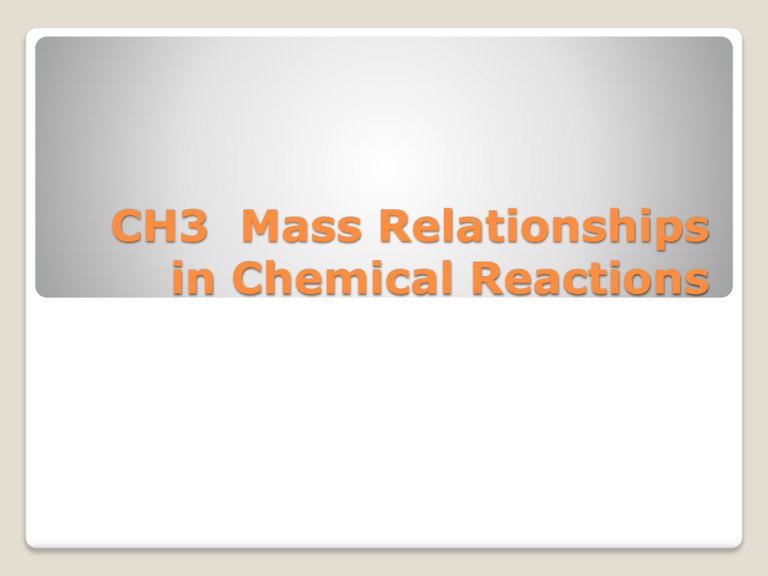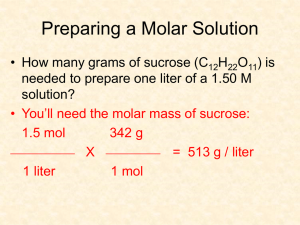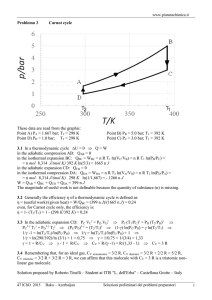Mole Relationships and Percent Composition
advertisement

CH3 Mass Relationships in Chemical Reactions C(s) + O2(g) 1 atom C + 1 molecule O2 CO2(g) 1 molecule carbon dioxide 1 atom C = 12.0107 amu Use ATOMIC MASS UNITS – “amu” 1 amu = 1.66 x 10-24g Mass of 1 carbon atom = 1.99 x 10-23g Mass of 1000. carbon atoms in amu (1000. C atoms) 12.01 amu = 12,010 amu 1 C atom Pile of carbon weighs 3.00 x 1020 amu (3.00 x 1020 amu) 1 C atom = 2.50 x 1019 carbon atoms 12.01 amu Calculating AMU and atoms Calculating the mass of 1000 carbon atoms (12,010 amu) 1.66 x 10-24g = 1.99 x 10-20g 1 amu Too difficult to weigh!! What is the mass in grams of 6.022 x 1023 atoms of carbon? Scientists determined how many carbons were in 12.01g carbon. Found to be 6.022 x 1023 atoms We now call this Avogadro’s number! The periodic tables gives use the mass of each element in terms of amu/atom and g/mol!! For ease, scientists renamed Avogadro’s number of atoms or molecules a mole Aluminum 1 mole 6.02 x 1023 atoms 26.98g Sulfur 1 mole 6.02 x 1023 atoms 32.07g Water 1 mole 6.02 x 1023 molecules 18.02g The MOLE You have 0.500g Na. How many moles of sodium do you have? 0.500g Na x 1 mol Na 22.99g Na = 0.0217 mol Na How many atoms of sodium are in 0.500g Na? 23 0.0217mol Na x 6.022 x 10 atoms 1 mol Na = 1.31 x 1022 atoms Na You have 5.00 x 1020 Cr atoms. How many moles do you have? What is the mass (in grams)? 5.00 x 1020 Cr atoms x ( 1 mol Cr ) 6.022 x 1023 Cr atoms = 8.30 x 10-4 mol Cr 8.30 x 10-4 mol Cr x (51.996 g Cr) 1 mol Cr = 0.0432 g Cr A molecule or chemical compound is a collection of atoms CH4 - contains 1 carbon and 4 hydrogen 5 CH4 – contains 5 carbon and 20 hydrogen Therefore…. Avogadro’s Number of CH4 And… Avogadro’s Number of C atoms 4X Avogadro’s Number of H atoms 1 mol CH4 = 1 mol C + 4 mol H Molar Mass 1 mol C + 4 mol H = 1 mol CH4 12.01 g C mol C + 4 x (1.008g H) = 16.04g CH4 mol H mol CH4 Molar Mass – mass of 1 mol of any compound (in grams) Molar Mass continued What is the molar mass of SO2? 1 mol S 1 mol SO2 2 mol O 1 mol SO2 x (32.06 g S) = 32.06 g S/mol SO2 mol S x (15.999 g O) = 31.998 g O/mol SO2 mol O 64.062 g SO2 mol SO2 . Determine the molar mass of C2H5Cl 2 mol C x (12.01 g C) = 24.02 g C/mol C2H5Cl 1 mol C2H5Cl mol C 5 mol H x (1.008 g H) = 5.04 g H/mol C2H5Cl 1 mol C2H5Cl mol H 1 mol Cl x (35.45 g Cl) = 35.45 g Cl/mol C2H5Cl 1 mol C2H5Cl mol Cl 64.51 g C2H5Cl mol C2H5Cl . Calcium Carbonate, CaCO3. 1.Calculate the molar mass. 2.A certain sample contains 4.86 mol. What is the mass in grams of this sample? 3.How many calcium carbonate molecules are in this sample? Calculating Number of Molecules So far, we’ve learned to look at molecules for the numbers/moles of constituent atoms It can be useful to know a compound’s composition in terms of masses of elements We use mass percent to describe the mass of an element in a mole of compound Percent Composition Mass Percent Mass % for a given element = mass of the element present in 1 mol molecule mass of 1 mol molecules x 100% Calculating mass % of sulfur and oxygen in SO2 1. Calculate the mass of 1 mole SO2 2. Calculate the mass of sulfur in 1 mole SO2 3. Calculate the mass of oxygen in 1 mole SO2 4. Calculate the mass % of sulfur and oxygen in SO2 1. Calculate the mass of 1 mole SO2 1 mol S x (32.06 g S) = 32.06 g S/mol SO2 1 mol SO2 mol S 2 mol O x (15.999 g O) = 31.998 g O/mol SO2 1 mol SO2 mol O 64.062 g SO2 . mol SO2 2. Calculate the mass of sulfur in 1 mole SO2 1 mol S 1 mol SO2 x (32.06 g S) = 32.06 g S/mol SO2 mol S 3. Calculate the mass of oxygen in 1 mole SO2 2 mol O x (15.999 g O) = 31.998 g O/mol SO2 1 mol SO2 mol O 4. Calculate the mass % of sulfur and oxygen in SO2 32.06g S/mol SO2 x 100% = 64.062 g SO2/mol SO2 31.998 g O/mol SO2 x 100% = 64.062 g SO2/mol SO2 Calculating Mass % 50.04% S 49.96% O Let’s say we have 0.2015g of an unknown sample. We find that this sample contains 0.0806g carbon, 0.01353g H, and 0.1074g O. First lets see how many moles of each element we have. 0.0806g C x ( 1 mol C ) = 0.00671 mol C 12.01g C 0.01353g H x ( 1 mol H ) = 0.01342 mol H 1.0079g H 0.1074g O x ( 1 mol O ) = 0.00671 mol O 15.9994g O Formulas of Compounds Now let’s see how many atoms of each element are in the sample. 0.00671 mol C x (6.022 x 1023 atoms C) = 4.04 x 1021 C atoms 1 mol C 0.01342 mol H x (6.022 x 1023 atoms H) = 8.08 x 1021 H atoms 1 mol H 0.00671 mol O x (6.022 x 1023 atoms O) = 4.04 x 1021 O atoms 1 mol O What is the relationship and what does it tell you?? Formulas of Compounds The numbers of atoms of C, O, and H tell us several things about our sample. 1. 2. 3. There are the same number of carbon and oxygen atoms. There are twice as many hydrogen atoms as carbon or oxygen atoms. We can express the relative number of atoms as CH2O Formulas of Compounds How do we know that CH2O is our compound in our sample? Can our sample of molecules have C2H4O2 or C6H12O6? The answer is that we don’t know! So, CH2O is known as the empirical formula. Empirical formula expresses the smallest whole-number ratio of the atoms present. The molecular formula give the composition of the molecules that are present in the actual formula. C6H12O6 is the molecular formula for glucose while CH2O is the molecular formula of formaldehyde. Molecular vs. Empirical 1. 2. 3. Calculate the number of moles of each element. Divide the number of moles by the smallest number of moles. Examine the ratios. Only whole numbers are used in empirical formulas. Calculating Empirical Formulas An oxide of aluminum is formed by the reaction of 4.151g of aluminum with 3.692g of oxygen. Calculate the empirical formula for this compound. 4.151g Al x ( 1 mol Al ) = 0.1539 mol Al 26.98g Al 3.692g O x ( 1 mol O ) = 0.2308 mol O 15.9994g O 0.1539 mol Al = 1.000 mol Al 0.1539 x 2 = 2 mol Al 0.2308 mol O = 1.500 mol O 0.1539 x 2 = 3 mol O Al2O3 A white powder is analyzed and found to have an empirical formula of P2O5. The compound has a molar mass of 283.88g. What is the compounds molecular formula? 2 mol P x 30.97g P = 61.94 g P/mol P2O5 mol P2O5 mol P Molar Mass P2O5 = 141.94g 5 mol O x 15.9994g O = 79.99 g O/mol P2O5 mol P2O5 mol O 141.94 x (n) = 283.88 n=2 Therefore, P4O10 is the molecular formula Calculating Molecular Formulas







